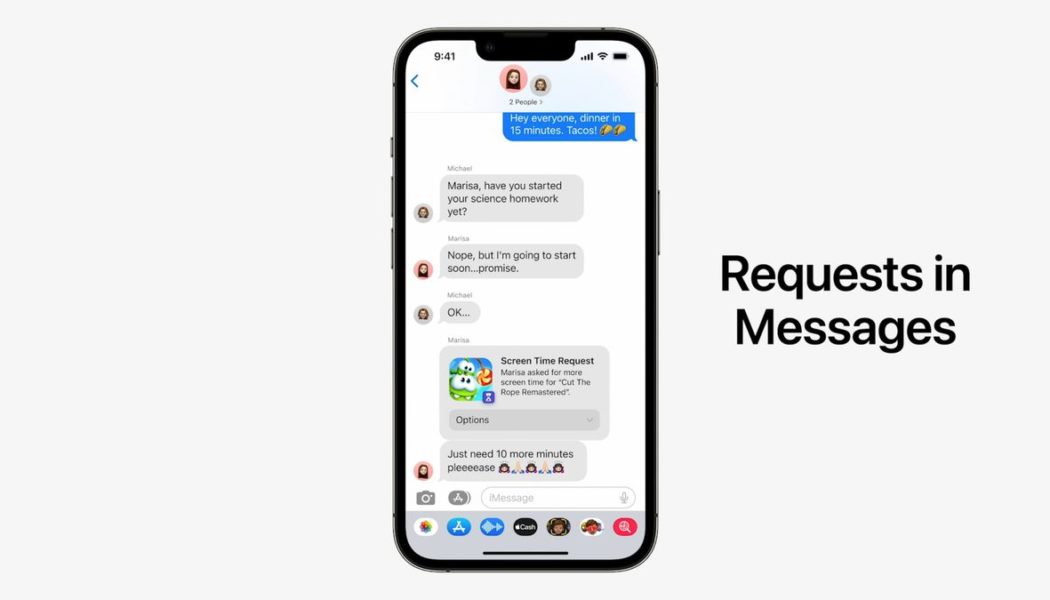I’m irrationally excited about a new feature coming to Apple’s Screen Time, the company’s gentler term for parental controls. When my kid wants that extra 15 minutes on her favorite app, her plaintive request will come through iMessage as well as a pop-up notification on my Apple devices.
Why is this exciting? Well, it’s a small thing, but if you miss that Screen Time notification, which is currently the only alert you get, you have to dive into the Settings app to manually address the request. This is fiddly and time-consuming, especially when you’re in the middle of making dinner, as it involves passcodes and multiple taps. With the request sitting handily in my Messages app with a dropdown menu that presumably will give me the same four options — approve for 15 minutes; an hour; all day; or, my favorite, don’t approve — I can handle the demand on my time rather than hers.
:no_upscale()/cdn.vox-cdn.com/uploads/chorus_asset/file/23611793/wwdc_2022_1111_10_21_29.jpg)
This feature will arrive with Apple’s new iOS 16 software update this fall, which will work with the iPhone 8 and later, the iPad (fifth generation and later), the iPad Mini (fifth generation and later), the iPad Air (third generation and later), and all iPad Pro models. It was announced at Apple’s WWDC conference this week, along with a few other upgrades to Family Sharing, Apple’s slightly confusing and very convoluted umbrella term under which Screen Time sits.
At their core, parental controls go against Apple’s privacy-first ethos, which probably explains why getting the features many parents want to make sure their children are using their devices safely has felt a bit like pulling teeth. But when Screen Time finally launched in 2018, it made it possible to see how long your child was on their device, limit the time they could use it, specify which apps they could access and for how long, and, crucially, manage it all from your device rather than only on your child’s device.
:no_upscale()/cdn.vox-cdn.com/uploads/chorus_asset/file/23611790/wwdc_2022_1109_10_58_28.jpg)
Apple’s Screen Time is still not as easy to use or as robust as Amazon’s parental controls for its services and Fire tablets, which include activity reports so you can see exactly what your child has been doing. But Apple’s options are now at least less confusing than Google’s Family Link, which, like many Google services, is constantly shifting and a pain to implement and manage.
With iOS 16, Apple promises to simplify the setup process, letting existing Screen Time settings automatically transfer to new devices and providing guidance for selecting the right types of content restrictions based on your child’s age when you set up their first device.
:no_upscale()/cdn.vox-cdn.com/uploads/chorus_asset/file/23612361/wwdc_2022_1113_10_44_29.jpg)
There’s also a new Family Checklist feature that Apple showed briefly during the WWDC keynote, which looks like it will provide a sort of one-stop shop for parents to better understand the tools Apple offers and how to tweak them as their child gets older. Apple’s biggest selling point for parents is how integrated it is — and Family Sharing means you don’t have to buy the same apps or subscriptions multiple times. But it seems like a lot of people don’t realize this (based on my unscientific survey of my kids’ friends’ parents who are constantly asking for my help to figure it out.) Hopefully, Family Checklist will help with this.
Another new feature for families is an iCloud Shared Photo Library. Up to six users can collaborate on and contribute to the photo library, and while it’s not clear exactly how it will differ from the Shared Albums feature, which is how my family currently shares images, I am intrigued by the automatic sharing feature that can be toggled on in the camera app. It would be nice if this were a toggle you keep turned on for your children’s devices, as seeing exactly what your tween has been taking pictures of is a feature some parents might appreciate.
:no_upscale()/cdn.vox-cdn.com/uploads/chorus_asset/file/23611792/wwdc_2022_1112_10_39_29.jpg)
These are all useful, if incremental, improvements. But I want Apple to allow me more control over my child’s devices, especially when they are a little older and want to explore more of the internet. I’m a tech journalist; I know about the delights and dangers of the online world. I want my children to benefit from the good experiences while shielding them from the bad. I also want to know about it when they run into something concerning.
There are several paid third-party services, such as Bark, Net Nanny, and Qustodio, that can monitor your child’s online activity — from messaging to social media posts — and alert you to potential issues (not provide a blow-by-blow of every emoji-laden communication ever made). But none of them work comprehensively on Apple devices, and this is a source of frustration for me. I even suggested my son switch back to Android, which allows these services — but the dreaded green bubble is just too powerful.
Privacy advocates will tell me “You should trust your child.” I do trust them, and I constantly discuss with them why I have controls set up and what they should be watching out for when they’re online. It’s other people I don’t trust. It’s like learning to drive; you can teach your child to be the safest, most courteous driver ever, but you can’t control the other drivers they meet on the road.









